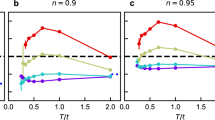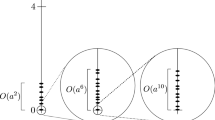Abstract
The Fermi Hypernetted-Chain theory and the Effective Correlation Factor method is applied to study the Laughlin states describing the fractional quantum Hall effect. Employing this formalism we evaluate the correlation energy, the radial distribution function, and the static structure factor, in the thermodynamic limit. The results obtained are similar to the boson Hypernetted-Chain treatment, usually adopted. The approach can be generalized to treat other correlated wave functions, such as wave functions of the composite fermion type for the fractional quantum Hall effect, in the thermodynamic limit.
Similar content being viewed by others
References
J. M. Caillol, D. Levesque, J. J. Weis, and J. P. Hansen,J. Stat. Phys. 28, 325 (1982).
J. P. Hansen and D. Levesque,J. Phys. C 14, L603 (1981).
S. Fantoni and R. Rosati,Nuovo Cim. Lett. 10:545 (1974); S. Fantoni and S. Rosati,Nuovo Cim. A 25, 593 (1975).
E. Krotscheck and M. L. Ristig,Phys. Lett. A 48:17 (1974); E. Krotscheck and M. L. Ristig,Nucl. Phys. A 242, 389 (1975).
D. C. Tsui, H. L. Stormer, and A. C. Gossard,Phys. Rev. Lett. 48, 1559 (1982).
For a review seeThe Quantum Hall Effect, R. E. Prange and S. M. Girvin (eds.), Springer Verlag, New York (1990);The Fractional Quantum Hall Effect, T. Chakraborty and P. Pietiläinen, (Springer Verlag, New York, 1988).
R. B. Laughlin,Phys. Rev. Lett. 50, 1395 (1983).
T. Chakraborty,Phys. Rev. B 31, 4026 (1985).
P. Pietilainen and T. Chakraborty,Europhys. Lett. 5, 157 (1988).
J. K. Jain,Phys. Rev. Lett. 63, 199 (1989).
J. W. Kim, Diploma Thesis, Institut für Theoretische Physik, Universität zu Köln, 1992 (unpublished).
F. Lado,J. Chem. Phys. 47, 5369 (1967).
J. G. Zabolitzky,Phys. Rev. B 22, 2353 (1980).
D. Levesque, J. J. Weis, and A. H. MacDonald,Phys. Rev. B 30 1056 (1984).
S. M. Girvin, A. H. MacDonald, and P. M. Platzman,Phys. Rev. B 33, 2481 (1986).
O. Ciftja and S. Fantoni,Europhys. Lett. 36, 663 (1996).
N. E. Bonesteel,Phys. Rev. B 51, 9917 (1995).
Author information
Authors and Affiliations
Rights and permissions
About this article
Cite this article
Ciftja, O., Fantoni, S., Kim, J.W. et al. Application of the Fermi Hypernetted-Chain theory and Effective Correlation Factor method for laughlin quantum Hall states. J Low Temp Phys 108, 357–371 (1997). https://doi.org/10.1007/BF02397679
Received:
Revised:
Issue Date:
DOI: https://doi.org/10.1007/BF02397679




